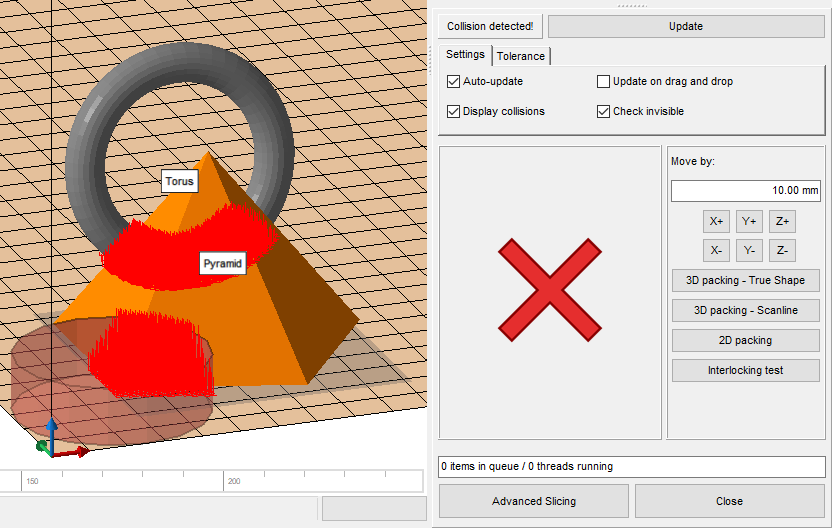Testing for geometry between parts that touch within tolerance or even overlap
 Collision detection checks whether any individual parts in the project touch or overlap with each other or with no-build zones. It is also launched automatically when using the packers.
Collision detection checks whether any individual parts in the project touch or overlap with each other or with no-build zones. It is also launched automatically when using the packers.
 Repair to check for
self-intersections.
Repair to check for
self-intersections.
To check for collisions
- From the main menu, choose .
This performs an initial check. You may want to adjust the settings to fit your workflow and triangle count if the impact on performance is unsuitable to keep the check updated automatically when rotating or moving the part around.

The density of the collision indicator lines is set by the
Resolution parameter on the
Tolerance tabsheet. The color is defined in
 Settings.
Settings.
Collision detection reference
These controls appear in the context view while the collision detection command is active.
| Control | Description | Range |
|---|---|---|
| Update |
If any automatic update of collision checking is disabled, say, for performance reasons, use this button to update the check manually. |
|
| Auto-update |
Reruns the collision check every time a part's position, size, or orientation is changed. |
|
| Update Drag and Drop |
Reruns the collision check during rotation or moving while the mouse button is still held down. |
|
| Display collisions |
When checked, Netfabb renders a 3D grid over the intersecting area. When unchecked, collisions are only indicated by the warning symbol, red X or green checkmark. |
|
| Check invisible |
When unchecked, hidden parts are disregarded in the collision check. |
|
| Move by |
Controls to adjust the position in increments in X, Y, and Z directions |
0 mm to 1000 mm |
| 3D packing - True shape, 3D packing - Scanline, 2D Packing, Interlocking test |
Shortcuts to packing and testing for interlocks |
|
| Advanced slicing |
Opens a dialog, Export platform as slices. This creates an export in the SLI format for every part. Note: This slicing avenue is deprecated and only included for legacy purposes. In general, you should rather generate toolpaths either through the
workspaces or
Slicing in the project tree.
|
|
| Tolerance | ||
| Resolution |
Determines the grid for checking collisions. The finer the grid, the more time the calculation takes. |
0.5 mm to 2 mm |
| Minimum distance |
Requires parts to be separated by at least this distance at any point |
0 mm to 6 mm |
